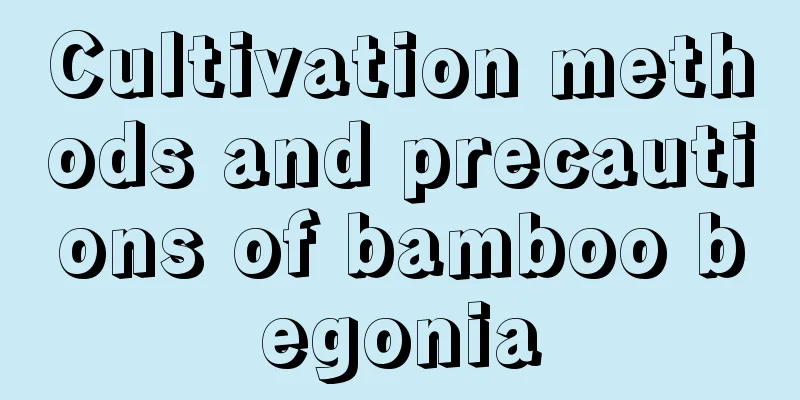Cultivation methods and precautions of bamboo begonia

|
The scientific name of the bamboo begonia is Zhujie Begonia, which is a perennial herb in the Begoniaceae family. It has beautiful flower shapes and bright colors, and looks beautiful with its soft leaves. Below I will introduce to you the cultivation methods and precautions of bamboo begonia. 1. Soil requirements The best choices for potted bamboo begonias are compost soil, leaf mold and charcoal soil. Alkaline or heavy clay soil that easily becomes compacted is not conducive to the growth of new roots when used for potted plants, and will cause the stems and leaves to be short and dull in color, and may easily cause chlorosis. It grows best in neutral soil with a pH of 6.5-7.5. 2. Lighting requirements Bamboo Begonia is suitable for growing in a semi-shady environment, especially in an environment with sufficient scattered light. It is very sensitive to strong light, and its leaves are easily burned under strong sunlight. Therefore, it needs shade in the summer or when the sunlight is strong. It is best to keep it in an environment with sufficient morning light or scattered light. 3. Suitable for watering Bamboo Begonia likes to grow in a humid environment. High air humidity is conducive to its growth. Insufficient water will cause its stems and leaves to fall over, which will seriously affect its growth. Daily maintenance should be done by watering in time. Do not wait until the soil in the pot is completely dry before watering. Keep the soil sufficiently moist. At the same time, avoid water accumulation in the pot, so the pot soil needs to have good drainage capabilities. 4. Pay attention to topdressing The growth of bamboo begonia requires a lot of nutrients, which need to be obtained from the soil on the one hand, and artificially supplemented on the other hand. Before flowering, phosphorus and potassium fertilizers need to be applied to promote flower bud differentiation and make the flowers more beautiful. For daily maintenance, compound fertilizers or organic liquid fertilizers can be used. Fertilize according to the principle of thin fertilizers and frequent applications. Do not over-fertilize, otherwise fertilizer damage will cause the plant to wither. 5. Pruning matters During the growth process of bamboo begonia, timely pruning is also very important, which is conducive to maintaining a good plant shape. When the plant is too tall or the leaves fall off, you can prune it in conjunction with repotting in spring, cutting off all the parts that cause the plant to have an unsightly shape. This will help the plant sprout new branches and produce more brightly colored flowers. 6. Pay attention to the temperature In a warm environment, the bamboo begonia grows faster and tends to have lush branches and leaves and bright flowers. The more suitable temperature is 19~24℃, and the wintering temperature should not be lower than 10℃, otherwise its leaves will easily be frostbitten. However, even if its leaves are frozen, its rhizomes can still grow new leaves next year. The rhizome has good cold resistance. 7. Pay attention to pests and diseases Excessively high temperatures and humid weather in summer can make Begonia susceptible to diseases and insect pests. Pest and disease control requires enhanced ventilation and light transmission. At the same time, do not allow a large amount of water to accumulate in the pot, and spray fungicides once every 15 days. When red spider mites are found on the bamboo begonia, you can spray 1500 times diluted trichloronate. If a small amount of scale insects are found, you can brush them off manually. That’s it |
<<: Planting technology of Chinese yam in the south
>>: Cultivation methods and precautions of Jinyumantang flower
Recommend
What is the difference between Lingjian Lotus and Epiphyllum?
See flowering time The most obvious difference be...
What to do if the leaves of coral vine seedlings turn yellow
The reason why the leaves of coral vine turn yell...
What to do if the leaves of the golden diamond curl outwards
1. Proper shade 1. Reason: Diamondwood likes sunl...
Can osmanthus trees be pruned? The three best time periods for pruning osmanthus trees
Osmanthus trees can be pruned . There are three m...
Where are the suitable places for planting winter jujube?
Winter jujube planting conditions 1. Temperature:...
How to grow cardinal coral and how to trim it
1. Temperature and humidity Cardinal coral origin...
What fertilizer is best for sweet potatoes?
Sweet potato is a popular crop. Not only are its ...
What to do if you water hibiscus too much
The harm of excessive watering of hibiscus You ca...
Can I grow a papaya tree at home?
Can I grow a papaya tree at home? Papaya trees ca...
Why Mimosa is not shy in winter
Why is Mimosa shy? When we touch the mimosa, we c...
How to care for kumquat in winter
Is kumquat afraid of cold? The suitable temperatu...
Cultivation methods and precautions of ball chrysanthemum
Ball chrysanthemum is very easy to grow. It is a ...
Cultivation methods and precautions of black heart chrysanthemum
How to grow black chrysanthemum soil Rudbeckia ha...
What is the best season to plant mint? What is the best month to start planting?
There are many methods for growing mint, includin...
Growth environment and characteristics of wintersweet
Wintersweet Growth Environment and Conditions Win...









